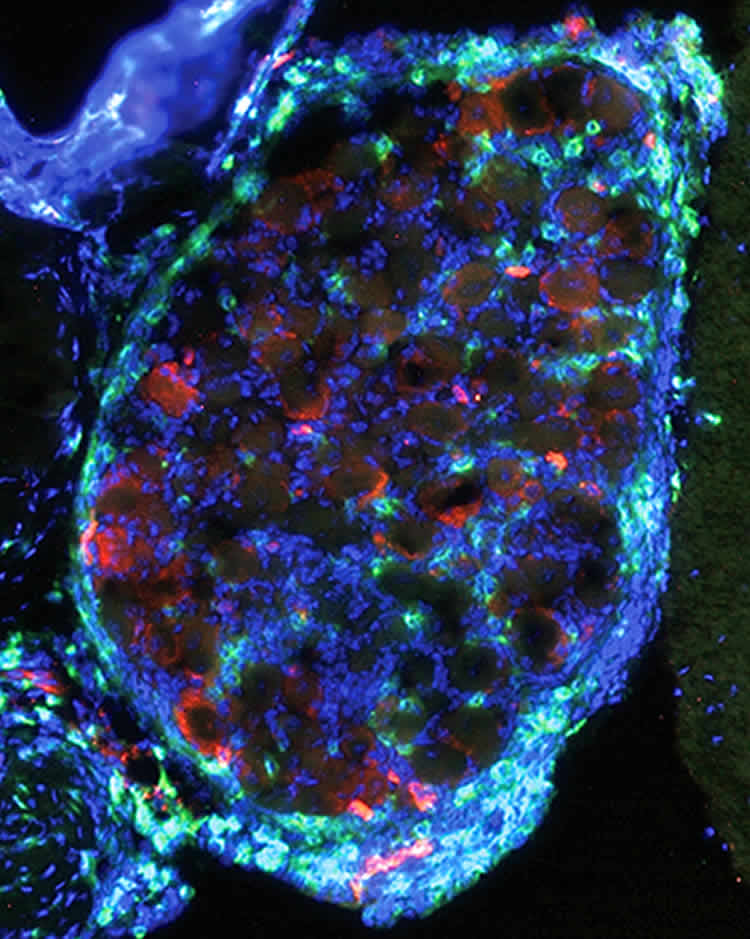Summary: Researchers report they have solved the puzzle as to how antibodies enter the nervous system to control viral infections.
Source: Yale.
Yale scientists have solved a puzzle of the immune system: how antibodies enter the nervous system to control viral infections. Their finding may have implications for the prevention and treatment of a range of conditions, including herpes and Guillain-Barre syndrome, which has been linked to the Zika virus.
Many viruses — such as West Nile, Zika, and the herpes simplex virus — enter the nervous system, where they were thought to be beyond the reach of antibodies. Yale immunobiologists Akiko Iwasaki and Norifumi Iijima used mice models to investigate how antibodies could gain access to nerve tissue in order to control infection.

In mice infected with herpes, they observed a previously under-recognized role of CD4 T cells, a type of white blood cell that guards against infection by sending signals to activate the immune system. In response to herpes infection, CD4 T cells entered the nerve tissue, secreted signaling proteins, and allowed antibody access to infected sites. Combined, CD4 T cells and antibodies limited viral spread.
“This is a very elegant design of the immune system to allow antibodies to go to the sites of infection,” said Iwasaki. “The CD4 T cells will only go to the site where there is a virus. It’s a targeted delivery system for antibodies.”
The finding has multiple implications, said the researchers. Without CD4 T cells, antibody-based therapies that are being developed for conditions like herpes may not be sufficient to control infection, Iwasaki noted. Conversely, for antibody-mediated autoimmune diseases such as Guillain-Barre, “it may be beneficial to block CD4 from entering the neuronal tissues,” she said.
Funding: The study was funded by the National Institutes of Health, and the Howard Hughes Medical Institute.
Source: Ziba Kashef – Yale
Image Source: This NeuroscienceNews.com image is credited to Norifumi Iijima.
Original Research: Abstract for “Access of protective antiviral antibody to neuronal tissues requires CD4 T-cell help” by Norifumi Iijima and Akiko Iwasaki in Nature. Published online May 18 2016 doi:10.1038/nature17979
[cbtabs][cbtab title=”MLA”]Yale. “How Antibodies Access Neurons to Fight Infection.” NeuroscienceNews. NeuroscienceNews, 20 May 2016.
<https://neurosciencenews.com/cd4-tcells-antibodies-4260/>.[/cbtab][cbtab title=”APA”]Yale. (2016, May 20). How Antibodies Access Neurons to Fight Infection. NeuroscienceNews. Retrieved May 20, 2016 from https://neurosciencenews.com/cd4-tcells-antibodies-4260/[/cbtab][cbtab title=”Chicago”]Yale. “How Antibodies Access Neurons to Fight Infection.” NeuroscienceNews.
https://neurosciencenews.com/cd4-tcells-antibodies-4260/ (accessed May 20, 2016).[/cbtab][/cbtabs]
Abstract
Access of protective antiviral antibody to neuronal tissues requires CD4 T-cell help
Circulating antibodies can access most tissues to mediate surveillance and elimination of invading pathogens. Immunoprivileged tissues such as the brain and the peripheral nervous system are shielded from plasma proteins by the blood–brain barrier1 and blood–nerve barrier2, respectively. Yet, circulating antibodies must somehow gain access to these tissues to mediate their antimicrobial functions. Here we examine the mechanism by which antibodies gain access to neuronal tissues to control infection. Using a mouse model of genital herpes infection, we demonstrate that both antibodies and CD4 T cells are required to protect the host after immunization at a distal site. We show that memory CD4 T cells migrate to the dorsal root ganglia and spinal cord in response to infection with herpes simplex virus type 2. Once inside these neuronal tissues, CD4 T cells secrete interferon-γ and mediate local increase in vascular permeability, enabling antibody access for viral control. A similar requirement for CD4 T cells for antibody access to the brain is observed after intranasal challenge with vesicular stomatitis virus. Our results reveal a previously unappreciated role of CD4 T cells in mobilizing antibodies to the peripheral sites of infection where they help to limit viral spread.
“Access of protective antiviral antibody to neuronal tissues requires CD4 T-cell help” by Norifumi Iijima and Akiko Iwasaki in Nature. Published online May 18 2016 doi:10.1038/nature17979






